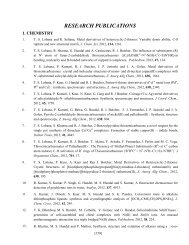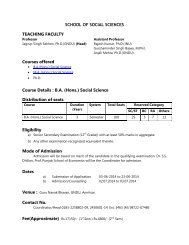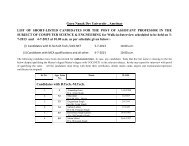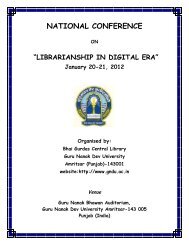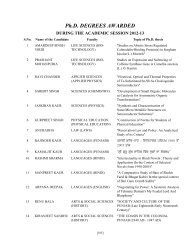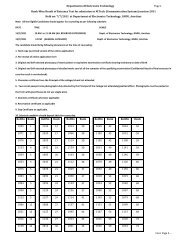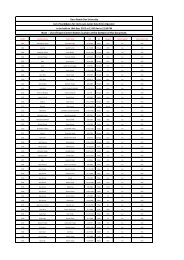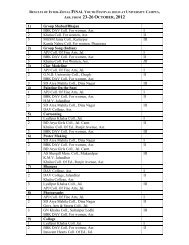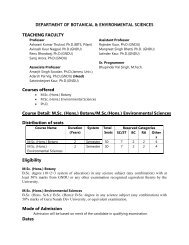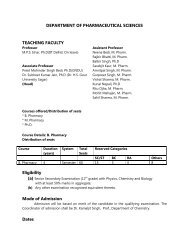(FASHION DESIGNING) (Semester I & II) - Guru Nanak Dev University
(FASHION DESIGNING) (Semester I & II) - Guru Nanak Dev University
(FASHION DESIGNING) (Semester I & II) - Guru Nanak Dev University
You also want an ePaper? Increase the reach of your titles
YUMPU automatically turns print PDFs into web optimized ePapers that Google loves.
FACULTY OF SCIENCES<br />
SYLLABUS<br />
FOR<br />
B.Sc. (<strong>FASHION</strong> <strong>DESIGNING</strong>)<br />
(<strong>Semester</strong> I & <strong>II</strong>)<br />
and<br />
(PART- <strong>II</strong> &<strong>II</strong>I)<br />
Examinations: 2012-13<br />
GURU NANAK DEV UNIVERSITY<br />
AMRITSAR<br />
Note: (i) Copy rights are reserved.<br />
Nobody is allowed to print it in any form.<br />
Defaulters will be prosecuted.<br />
(ii) Subject to change in the syllabi at any time.<br />
Please visit the <strong>University</strong> website time to time.
ELIGIBILITY:<br />
1<br />
B.Sc. <strong>FASHION</strong> <strong>DESIGNING</strong> (SEMESTER SYSTEM)<br />
1. The admission to this course shall be open to the candidates who have passed Senior<br />
Secondary Part-<strong>II</strong> (12 th Class) examination of Punjab School Education Board, Mohali<br />
with minimum of 45% marks in aggregate.<br />
OR<br />
Any other examination with 45% marks in aggregate, recognized as equivalent to above<br />
by the <strong>Guru</strong> <strong>Nanak</strong> <strong>Dev</strong> <strong>University</strong>.<br />
NOTE: DETAILED ORDINANCES RELATING TO EXAMINATION FOR THIS CLASS ARE<br />
CONTAINED IN THE GURU NANAK DEV UNIVERSITY CALENDAR VOL. <strong>II</strong> READ<br />
WITH SYNDICATE DECISIONS / AMENDMENTS MADE FROM TIME TO TIME.<br />
Paper Subject Theory<br />
Marks<br />
I Basic of Design and<br />
Illustration<br />
<strong>II</strong><br />
<strong>II</strong>I<br />
IV<br />
V<br />
Concept of Fashion<br />
Basics of Sewing-I<br />
Textile Chemistry – I<br />
English(Compulsory)<br />
<strong>Semester</strong> – I<br />
Scheme of Studies<br />
Duration Practical Duration Int.<br />
Ass.<br />
Total<br />
50 3 Hrs. 40 3 Hrs. 10 100<br />
100<br />
50<br />
50<br />
50<br />
3 Hrs.<br />
3Hrs.<br />
3 Hrs.<br />
3 Hrs.<br />
35<br />
30<br />
4 Hrs<br />
3 Hrs.<br />
15<br />
20<br />
Total<br />
100<br />
100<br />
100<br />
50<br />
450
Paper<br />
I<br />
<strong>II</strong><br />
<strong>II</strong>I<br />
IV<br />
V<br />
VI<br />
Subject<br />
2<br />
B.Sc. <strong>FASHION</strong> <strong>DESIGNING</strong> (SEMESTER SYSTEM)<br />
Traditional Textile<br />
Fabric Construction<br />
Basics of Sewing-<strong>II</strong><br />
Basic of Computers<br />
Industrial Visits at least<br />
two units and<br />
submission of report=20<br />
Seminar on any topic<br />
from theory course=30<br />
considered as external<br />
examination(Practical)<br />
(20+30)<br />
English(Compulsory)<br />
<strong>Semester</strong>-<strong>II</strong><br />
Scheme of Studies<br />
Theory<br />
Marks<br />
50<br />
50<br />
50<br />
50<br />
Duration<br />
3 Hrs.<br />
3 Hrs.<br />
3 Hrs.<br />
3 Hrs.<br />
Practical<br />
35<br />
30<br />
35<br />
70<br />
50<br />
Duration<br />
3 Hrs.<br />
3 Hrs.<br />
4 Hrs<br />
3 Hrs.<br />
Int.<br />
Ass.<br />
15<br />
20<br />
15<br />
30<br />
Total<br />
100<br />
100<br />
100<br />
150<br />
50 3 Hrs. 50<br />
Total<br />
50<br />
550
Part-<strong>II</strong>:<br />
Scheme of Examination:<br />
3<br />
B.Sc. <strong>FASHION</strong> <strong>DESIGNING</strong> (ANNUAL SYSTEM)<br />
No. Subject Theory Duration Practical Duration Int. Total<br />
Marks<br />
Ass.<br />
1. Fashion Design Illustration - - 100 3 Hrs. - 100<br />
2. History of Costumes and<br />
Accessories<br />
100 3 Hrs. 40 3 Hrs. 10 150<br />
3. Pattern Making & Garment<br />
Construction<br />
100 3 Hrs. 80 4 Hrs. 20 200<br />
4. Textile Chemistry-<strong>II</strong> 50 3 Hrs. 40 3 Hrs. 10 100<br />
5. Needle Craft - - 100 3 Hrs. - 100<br />
6. Pattern & Marker Making in<br />
Computer<br />
- - 80 3 Hrs. 20 100<br />
7. Knitting and Leather<br />
Technology<br />
100 3 Hrs. 40 3 Hrs. 10 150<br />
8. Punjabi/ PHC 100 3 Hrs. - - - 100<br />
9. * Environmental Studies<br />
(Compulsory Paper)<br />
- - - - - -<br />
* Marks will not be included in the total marks.<br />
Total: 1000
PART-<strong>II</strong>I:<br />
Scheme of Examination:<br />
4<br />
B.Sc. <strong>FASHION</strong> <strong>DESIGNING</strong> (ANNUAL SYSTEM)<br />
No. Subject Theory Duration Internship Practical Duration Int. Total<br />
Marks<br />
Ass.<br />
1. Fashion<br />
Illustration &<br />
Application<br />
_ _ _ 100 3 25 125<br />
2. Draping,<br />
Pattern Making<br />
& Construction<br />
_ _ _ 125 3 25 150<br />
3. CAD _ _ _ 100 3 25 125<br />
4. Survey &<br />
Project Report<br />
_ _ _ 100 _ 25 125<br />
5. Internship for<br />
Design &<br />
Construction of<br />
Garments<br />
_ _ 100 _ _ 50 150<br />
6. Knitting 100 3 _ _ _ 25 125<br />
7. Fashion<br />
Industry<br />
(Marketing &<br />
Management<br />
100 3 _ _ _ _ 100<br />
8. Communication<br />
Skills<br />
100 3 _ _ _ _ 100<br />
Total: 1000<br />
*. Internship to be done in autumn & winter vacations (1 month) and submit a report for internal<br />
assessment.
5<br />
B.Sc. <strong>FASHION</strong> <strong>DESIGNING</strong> (SEMESTER–I)<br />
I. BASICS OF DESIGN AND ILLUSTRATION<br />
Time: 3 hrs. Max. Marks: 100<br />
Total Period: (3+6) Per Week Theory Marks: 50<br />
Practical Marks: 40<br />
Internal Asst.:10<br />
Instructions for the Examiners/Paper Setters:<br />
Each question paper of theory will consist of eight questions and a candidate has to attempt five<br />
out of these. Each question will be of 10 marks. Practical Paper will be set on the spot.<br />
OBJECTIVES:<br />
To help students to understand design fundamental, elements and principles of design.<br />
To enable students to gain knowledge of figure sketching and drawing.<br />
To understand the fashion design concepts, illustration techniques and colour theories.<br />
THEORY:<br />
Introduction to art media and its application, different art media like pencils, pencil colours,<br />
crayons, poster colours, erasers, acrylic rendering and shading skills.<br />
Elements of art and design - line, form, shape, space, size, textures and colour.<br />
Colour - dimensions of colour (hue, value, and intensity), colour schemes, their importance<br />
and applications.<br />
Design - definition and types.<br />
Introduction and brief history of fashion illustration.<br />
Fashion model drawing, Basic human proportion, body figures and shapes.<br />
PRACTICAL<br />
Time: 3 hrs. Marks: 40<br />
Introduction to art media and its application.<br />
The basic drawing and rendering of equipments using, pencils, crayons, poster and acrylic<br />
colours etc.<br />
Introduction to basic sketching techniques.<br />
Free hand sketching of day to day objects - flowers, flowerpots, leaves, barks,<br />
scenery(natural), houses, computer(conventional), basic geometrical figures composed into<br />
interesting composition by combining different shapes(geometric) and all other kinds of<br />
drawings(abstract).<br />
Colour-Preparation of colour wheel, grey scales, colour schemes and tints and shades.<br />
Figure stylization - Basic croquets, division of the body to make the 8 head figure, 10 head<br />
figure, 12 head figure, Fleshing out body.<br />
Figure in motion - Geometrical blocks to make different postures, Segregate into postures as<br />
normal standing, walking, running and sitting and fleshing of croquis.
6<br />
B.Sc. <strong>FASHION</strong> <strong>DESIGNING</strong> (SEMESTER–I)<br />
<strong>II</strong>. CONCEPT OF <strong>FASHION</strong> (THEORY)<br />
Time: 3 hrs.<br />
Total Periods: (6+0) Per Week Max. Marks: 100<br />
Instructions for the Examiners/Paper Setters:<br />
Each question paper of theory will consist of eight questions and a candidate has to attempt five<br />
out of these. Each question will be of 20 marks.<br />
OBJECTIVES:<br />
To create awareness about clothing culture.<br />
To impart knowledge of clothing communication and fashion expression.<br />
THEORY:<br />
Fashion Terminology - fashion, style, change, fashion cycles, fad, classic, boutique, croquie,<br />
fashion trends, haute couture, designer, pret-a-porter, silhouette.<br />
Fashion - Definition, importance, factors affecting fashion and difference of fashion and<br />
anti-fashion.<br />
Fashion - origin, evolution, cycles, lengths and breaks of fashion cycle.<br />
Fashion theories - trickle down, trickle across and bottom up theory.<br />
Fashion psychology - first impression, role of social and psychological aspect of clothing.<br />
Sociological choice of clothing as affected by nationality, tradition, class consciousness,<br />
occupation etc.
7<br />
B.Sc. <strong>FASHION</strong> <strong>DESIGNING</strong> (SEMESTER–I)<br />
<strong>II</strong>I. BASICS OF SEWING - I<br />
Time: 3 hrs. Max. Marks: 100<br />
Total Periods: (3+6) Per Week Theory Marks: 50<br />
Practical Marks: 35<br />
Internal Asst.: 15<br />
Instructions for the Examiners/Paper Setters:<br />
Each question paper of theory will consist of eight questions and a candidate has to attempt five<br />
out of these. Each question will be of 10 marks. Practical Paper will be set on the spot.<br />
OBJECTIVES:<br />
To impart knowledge of machines used for sewing.<br />
THEORY:<br />
Introduction to sewing history of sewing machines<br />
Sewing Machine - Different type of sewing machines, maintenance of sewing machines,<br />
common problems and their remedies, tools and equipments<br />
Introduction to manufacture of sewing thread and their properties<br />
Sewing techniques(Basic hand stitches) – Basting, running, tacking, hand overcast, hemming<br />
stitches(plain and blind), slip stitches, tailor, tack<br />
Seam and seam finishes – Definition, types of seams, finish and their applications<br />
Fullness – Darts, tucks, pleats, gathers (definition, types and their applications)<br />
Different type of pockets<br />
Fasteners – Definition, types and present trends<br />
Finishes – Neckline (binding, facing)<br />
Plackets – Definition and types<br />
PRACTICAL<br />
Time: 4 hrs. Marks: 35<br />
Introduction to different parts of sewing machine and their care and maintenance<br />
Basic hand stitches<br />
Seams and seam finishes – Plain, flat, run and fell, French, counter hem, mantua maker, over<br />
lock, hand over cast, turned and stitched, binding<br />
Fullness – Darts, tucks, pleats, gathers<br />
Neckline Finishes<br />
Plackets – continuous, two piece placket, extended bodice trimmings<br />
Pockets – Patch, welt, inseam, bound, flap, kurta pocket
8<br />
B.Sc. <strong>FASHION</strong> <strong>DESIGNING</strong> (SEMESTER–I)<br />
IV. TEXTILE CHEMISTRY-I<br />
Time: 3 hrs. Max. Marks: 100<br />
Total Periods: (9+3) Per Week Theory Marks: 50<br />
Practical Marks: 30<br />
Internal Asst.: 20<br />
Instructions for the Examiners/Paper Setters:<br />
Each question paper of theory will consist of eight questions and a candidate has to attempt five<br />
out of these. Each question will be of 10 marks. Practical Paper will be set on the spot.<br />
OBJECTIVES:<br />
To impart the knowledge of fibre, sources of fibres, their definitions and properties.<br />
To provide students with knowledge of yarn science and yarn properties.<br />
THEORY:<br />
Textile Terminology – Fibre, yarn, elasticity, absorbency, resiliency, drapability, twist, blend<br />
Introduction to textile fibres and their classification based on source and origin<br />
Manufacturing process and the properties of different fibres - Cotton, linen, wool, silk,<br />
viscose rayon, acetate rayon, nylon, polyester<br />
Application of these fibres with respect to end uses,<br />
Introduction to Yarn and Manufacturing process (different spinning process of yarn)<br />
Types and uses of yarn – Simple yarn, fancy yarns, textured yarns<br />
Yarn properties – Linear density, size, twist, twist direction, strength and uniformity<br />
PRACTICAL<br />
Time: 3 hrs. Marks: 30<br />
Microscopic appearance, burning test and solubility test for different fibres<br />
Visual identification of spun, filaments, cords, cable and fancy yarns<br />
Collection of different types of yarns
9<br />
B.Sc. <strong>FASHION</strong> <strong>DESIGNING</strong> (SEMESTER–I)<br />
V: ENGLISH (COMPULSORY)<br />
Time: 3 Hours Max. Marks: 50<br />
Texts Prescribed:<br />
1. Tales of Life (<strong>Guru</strong> <strong>Nanak</strong> <strong>Dev</strong> <strong>University</strong>, Amritsar)<br />
2. Prose for Young Learners (<strong>Guru</strong> <strong>Nanak</strong> <strong>Dev</strong> <strong>University</strong>, Amritsar)<br />
3. Murphy's English Grammar, (Raymond Murphy), 3rd Ed. CUP 2004, Rept. 2005.<br />
Course Contents:<br />
1) Stories at Sr.No.1,2,3,5,6 from Tales of Life.<br />
2) Essays at Sr.No.1,2,3,5,6 from Prose for Young Learners.<br />
3) Unit 1-37 from Murphy's English Grammar.<br />
Division of Marks:<br />
Section-A:<br />
Twenty (20) questions on the usage of grammar related to units 1-37 of<br />
Murphy's English Grammar. All questions will be compulsory.<br />
(½ x 20=10 Marks)<br />
Section-B:<br />
I. Eight (8) questions from the two literary texts (four from Tales, four from Prose). The<br />
students will be required to attempt any five choosing at least two questions from<br />
each prescribed text. The answers should not exceed 15 lines each. (3x5=15 Marks)<br />
<strong>II</strong>. Eight (8) questions on vocabulary testing meaning and usage of items glossed in the<br />
two prescribed text. All questions will be compulsory. (½x8=4 Marks)<br />
<strong>II</strong>I. Translation of a short passage from English to Hindi/Punjabi<br />
OR<br />
Precise of a short passage (only for foreign students who do not know<br />
Punjabi/Hindi. (5 Marks)<br />
Section-C:<br />
I. There will be two questions one from each literary text. The students will be required<br />
to answer any one.(1x8=8 Marks)<br />
Writing a paragraph (1 out of 2) (1x8=8 Marks)
10<br />
B.Sc. <strong>FASHION</strong> <strong>DESIGNING</strong> (SEMESTER–<strong>II</strong>)<br />
I. TRADITIONAL TEXTILES<br />
Time: 3 hrs. Max. Marks: 100<br />
Total Periods: (6+6) Per Week Theory Marks: 50<br />
Practical Marks: 35<br />
Internal Asst.: 15<br />
Instructions for the Examiners/Paper Setters:<br />
Each question paper of theory will consist of eight questions and a candidate has to attempt five<br />
out of these. Each question will be of 10 marks. Practical Paper will be set on the spot.<br />
OBJECTIVES:<br />
To impart knowledge of traditional design and motifs of textiles.<br />
To introduce applications of these motifs on the different textiles.<br />
THEORY:<br />
Floor coverings – Carpets and Durries<br />
Coloured Textiles – Bandhani, Patola, Ikkat.<br />
Woven Textiles – Brocades, Chanderi, Maheshwari, Kanjivaram, Baluchari<br />
Printed Textiles – Sanganeri<br />
Painted Textiles – Kalamkari<br />
Study of following traditional embroideries– Introduction, types, their traditional influences,<br />
symbolism, basic fabrics, decorative stitches, techniques and their colour combinations.<br />
- Kutch<br />
- Phulkari<br />
- Kantha<br />
- Kasuti<br />
- Chamba Rumal<br />
- Kashida<br />
- Chikankari<br />
PRACTICAL<br />
Time: 3 hrs. Marks: 35<br />
Sample making of following traditional embroideries<br />
Kutch of Gujarat<br />
Phulkari of Punjab<br />
Kantha of Bengal<br />
Kasuti of Karnataka<br />
Kashida of Kashmir<br />
Chikankari of Uttar Pradesh
11<br />
B.Sc. <strong>FASHION</strong> <strong>DESIGNING</strong> (SEMESTER–<strong>II</strong>)<br />
<strong>II</strong>. FABRIC CONSTRUCTION<br />
Time: 3 hrs. Max. Marks: 100<br />
Total Periods: (3+9) Per Week Theory Marks: 50<br />
Practical Marks: 30<br />
Internal Asst.: 20<br />
Instructions for the Examiners/Paper Setters:<br />
Each question paper of theory will consist of eight questions and a candidate has to attempt five<br />
out of these. Each question will be of 10 marks. Practical Paper will be set on the spot.<br />
OBJECTIVES:<br />
To impart knowledge of fabric manufacture and fabric properties.<br />
To enable students to understand fabric structures and to analyse them.<br />
THEORY:<br />
Different methods of fabric construction<br />
Loom – Definition, Principle, Parts, Types (shuttle and shuttle less looms) and Operations<br />
Weaving – Definition, Principle, Types (Basic and Novelty/Fancy Weaves)<br />
Basic Weaves – Plain weave, Twill weave and Satin weave, their variations and types<br />
Novelty/Fancy Weave – Pile weave and its types, Double cloth weave, Leno and Gauge<br />
weave, Jacquard weave, Dobby weave and its types, Swivel Weave, Lappet weave and creep<br />
weave<br />
Knitting – Definition and Techniques (Warp, Weft and their types)<br />
Felting – Definition, Manufacturing Process, Types, Properties and Uses<br />
Bonding – Definition, Manufacturing Process, Properties and Uses<br />
PRACTICAL<br />
Time: 3 hrs. Marks: 30<br />
Sample Making by various weaving techniques<br />
Preparation of one article
12<br />
B.Sc. <strong>FASHION</strong> <strong>DESIGNING</strong> (SEMESTER–<strong>II</strong>)<br />
<strong>II</strong>I. BASICS OF SEWING - <strong>II</strong><br />
Time: 3 hrs. Max. Marks: 100<br />
Total Periods: (3+9) Per Week Theory Marks: 50<br />
Practical Marks: 35<br />
Internal Asst.: 15<br />
Instructions for the Examiners/Paper Setters:<br />
Each question paper of theory will consist of eight questions and a candidate has to attempt five<br />
out of these. Each question will be of 10 marks. Practical Paper will be set on the spot.<br />
OBJECTIVES:<br />
To impart knowledge of machines used for sewing.<br />
THEORY:<br />
Terminology – Notches, grain, grain line, construction lines, centre front and back line, bias,<br />
true bias, bust line, waist line, seam line, seams, seam allowances, jog, darts, dart points,<br />
direction of dart excess, dart shape at pattern edge<br />
Anthropometric measurements – Study of all body measurements of all age groups<br />
(infants, children, women and men), standards of body measurements, importance,<br />
standardisation and size chart<br />
Drafting – Its importance and uses<br />
Introduction to pattern making and its tools<br />
Sleeves – Different types of sleeves<br />
Collars - Different types and styles of collars<br />
Yokes – Yokes with fullness and without fullness (definition, purpose, their application and<br />
construction)<br />
Trimmings - Different types of trimmings<br />
PRACTICAL<br />
Time: 4 hrs. Marks: 35<br />
Construction of sleeves – Puff, raglan, kimono, leg-o-mutton, flared, cap, Magyar, bishop<br />
Yokes – Yokes with fullness and without fullness<br />
Construction of collars – Flat and rolled peter pan collar, shawl collar, mandarin collar, wing<br />
collar, cape collar, baby collar, sailor collar<br />
Methods and preparation of basic blocks – Front bodice, back bodice and sleeve
13<br />
B.Sc. <strong>FASHION</strong> <strong>DESIGNING</strong> (SEMESTER–<strong>II</strong>)<br />
IV. BASIC OF COMPUTERS<br />
Time: 3 hrs. Max. Marks: 150<br />
Total Periods: (3+6) Per Week Theory Marks: 50<br />
Practical Marks: 70<br />
Internal Asst.: 30<br />
Instructions for the Examiners/Paper Setters:<br />
Each question paper of theory will consist of eight questions and a candidate has to attempt five<br />
out of these. Each question will be of 10 marks. Practical Paper will be set on the spot.<br />
OBJECTIVES:<br />
To impart basic computer knowledge to students.<br />
To enable students to understand the rules of IT in automation, fashion and apparels.<br />
THEORY (To be done in Practical classes):<br />
Introduction to computer, Data Processing, Information, Classification and Evaluations of<br />
computers<br />
Configurations of computers (Resolution Factors, Raster and Vector Data and image<br />
processing)<br />
Computer hardware – Central processing, main memory, secondary memory, I/O devices<br />
Operation system (OS) - Basic concepts, Window 7 or Vista<br />
MS Word processing, Worksheet, Business charts (Pie, Line Bar etc.)<br />
Operations and Professional presentation formations, MS - power point<br />
Computer applications in various fields of Fashion Industry, Fashion Communication through<br />
Digital Techniques, Fashion Photography<br />
Current trends – internet, Latest net explorers installation, configuration and applications,<br />
search engines<br />
PRACTICAL<br />
Time: 3 hrs. Marks: 70<br />
Introduction to the computer Operations:- Hardware and Software, Understanding OS and<br />
Basic System Management<br />
Power Point Package<br />
Word Procession software, preparation, saving and printing of text documents and usage of<br />
MS-Excel
14<br />
B.Sc. <strong>FASHION</strong> <strong>DESIGNING</strong> (SEMESTER–<strong>II</strong>)<br />
VI: ENGLISH (COMPULSORY)<br />
Time: 3 Hours Max. Marks: 50<br />
Texts Prescribed:<br />
1. Tales of Life (<strong>Guru</strong> <strong>Nanak</strong> <strong>Dev</strong> <strong>University</strong>, Amritsar)<br />
2. Prose for Young Learners (<strong>Guru</strong> <strong>Nanak</strong> <strong>Dev</strong> <strong>University</strong>, Amritsar)<br />
3. Murphy's English Grammar, (Raymond Murphy), 3rd Ed. CUP 2004, Rept. 2005.<br />
Course Contents<br />
1) Stories at Sr.No.7,9,10,11,12 from Tales of Life.<br />
2) Essays at Sr.No.7,8,9,10,11 from Prose for Young Learners.<br />
3) Unit 121-136, 69-91 from Murphy's English Grammar.<br />
Division of Marks:<br />
Section-A:<br />
Twenty (20) questions on the usage of grammar related to units 121-136, 69-91 of<br />
Murphy's English Grammar. All questions will be compulsory.<br />
(½ x 20=10 Marks)<br />
Section-B:<br />
I. Eight (8) questions from the two literary texts (four from Tales, four from Prose). The<br />
students will be required to attempt any five choosing at least two questions from<br />
each prescribed text. The answers should not exceed 15 lines each. (3x5=15 Marks)<br />
<strong>II</strong>. Eight (8) questions on vocabulary testing meaning and usage of items glossed in the<br />
two prescribed text. All questions will be compulsory. (½x8=4 Marks)<br />
<strong>II</strong>I. A personal letter (1 out of 2) (5 Marks)<br />
Section-C:<br />
I. There will be two questions one from each literary text. The students will be required<br />
to answer any one.(1x8=8 Marks)<br />
<strong>II</strong>. Comprehension of a passage (about 200 words) selected from either of the prescribed<br />
books of Prose or Tales. (4 short questions of 2 marks each) (4x2=8 Marks)
15<br />
B.Sc. <strong>FASHION</strong> <strong>DESIGNING</strong> (ANNUAL SYSTEM) PART-<strong>II</strong><br />
1. <strong>FASHION</strong> DESIGN ILLUSTRATIONS<br />
(PRACTICAL)<br />
Time: 3 hrs.<br />
Total Credit Periods: (00+03) Max. Marks: 100<br />
Instructions for the Examiners/Paper Setters:<br />
Paper will be set on the spot by the examiner.<br />
1. Set 3 questions from sketching part-25 marks each. Students are required to attempt any two.<br />
2. Set 2 questions from CAD part-25 marks each. Students are required to attempt any one.<br />
3. Scheme work-25 marks.<br />
OBJECTIVES:<br />
To enable students to gain knowledge of figure sketching and drawing.<br />
To understand the fashion design concepts.<br />
To acquaint students with knowledge of CAD based application in fashion designing.<br />
FLAT SKETCHING AND FIGURE DRAWING:<br />
Sketching of various garment details – collars, necklines, sleeves, cuffs<br />
Sketching of accessories for children, teenagers, youth, adults, casual and formal wear.<br />
Drawing the Garment<br />
- Understanding fabrics folds (Flat sketching of tops, skirts and trousers.)<br />
- Laying down multiple washes.<br />
- Rendering Texture of fabrics.<br />
Costume Anatomy (style lines)<br />
Garment draping on fashion figures.<br />
CAD:<br />
Croqui drawing in Computer.<br />
Drawing the details of the following and applying various texture and effects using<br />
different CAD Softwares.<br />
Fashion Details/Silhouette :<br />
Collar: Mandarin, High Bias, Tuxedo, Cape, Flat Tennis.<br />
Sleeves: Raglan, Hanky, Tulip, Ruffle, Dolmon<br />
Accessories: Bags, Belts, Caps, Bows.<br />
Pockets: Flap, Pouch, Patch, Cross, Slit, Kurta<br />
Skirts: Novelty, Gathered, Hip Rider, Trumpet, Pegged, Circular,<br />
Pleated, Straight, A-Line.<br />
Trousers: Jeans, Straight Pants, Baggy Pants, Jump Suit, Dungarees.<br />
Silhouette: A Line, funnel shaped, circular, straight, Rectangular<br />
Portfolio <strong>Dev</strong>elopment<br />
References:<br />
1. Ireland, Patrick John, “Fashion Design Drawing and Presentation”, B.T. Batsford,<br />
London, 1996.<br />
2. Elisabetta Drudi, T.Paci, “Figure Drawing for Fashion”, The Pepin Press.<br />
3. Allen and Seaman, “Fashion Drawing – The Basic Principles”, B.T. Batsford, London.<br />
4. Veisinet DD, “Computer Aided Drafting and Design – Concept and Application’, 1987.<br />
5. Taylor P, “Computers in the Fashion Industry”, Heinemann Pub., 1990.<br />
6. Winfred Aldrich, “CAD in Clothing and Textiles”, Blackwell Science 1994.
16<br />
B.Sc. <strong>FASHION</strong> <strong>DESIGNING</strong> (ANNUAL SYSTEM) PART-<strong>II</strong><br />
2. HISTORY OF COSTUMES AND ACCESSORIES<br />
Time: 3 hrs. Max. Marks: 150<br />
Total Credit Periods: (06+03) Theory Marks: 100<br />
Practical Marks: 40<br />
Int. Ass.: 10<br />
Instructions for the Examiners/Paper Setters:<br />
Set 8 questions of 20 marks each out of which any 5 questions have to be attempted.<br />
Practical paper will be set on the spot.<br />
OBJECTIVES:<br />
To acquaint the students with different types of costumes.<br />
To enhance the students knowledge regarding accessories and jewellery of different eras.<br />
To impart knowledge of fashion accessories and creativity.<br />
To provide opportunity for skill development in designing accessories.<br />
THEORY:<br />
Study of costumes from earlier times to present time.<br />
Indian Costumes<br />
- Indus Valley Period<br />
- Vedic Period<br />
- Mauryan and Sunga Period<br />
- Satavahana Period<br />
- Kushan Period<br />
- Gupta Period<br />
- Mughal Period<br />
- British Period<br />
- Post-Contemporary Period<br />
Costumes of various regions of India<br />
Design elements of costumes and their influence on historical, present and future<br />
clothing.<br />
Social, Economic and Historical events and their influence on fashion.<br />
Western Costumes – Egyptian, Greek, Roman, Byzantine, French.<br />
Introduction, definition, importance, history, classification.<br />
Textiles in Accessories.<br />
Other Decorative materials used to make accessories.<br />
Accessory types – Head gears, footwear, bows, ties, belts, hand bags and gloves.<br />
Materials and process - material required, material sourcing, design, development and<br />
production.<br />
Accessory design<br />
Marketing the accessories.<br />
ASSIGNMENT:<br />
Sketch costumes for men, women and children and accessories for the following :<br />
a. Indus valley civilization.<br />
b. Vedic age<br />
c. Mauryan<br />
d. Mughal<br />
Sketch costumes for men, women and children and accessories for East, West, North and<br />
South regions of India.<br />
Adapting period costume to contemporary use
17<br />
B.Sc. <strong>FASHION</strong> <strong>DESIGNING</strong> (ANNUAL SYSTEM) PART-<strong>II</strong><br />
PRACTICAL<br />
Time: 3 hrs. Marks: 40<br />
References:<br />
Sketching and Rendering of – Headgears, footwear, handbags, belts, gloves, earrings,<br />
necklaces and bangles.<br />
Preparation of any four accessories.<br />
1. Singh Kiran, “Textiles in Ancient India”, Vishwa Vidalaya.<br />
2. Oar S.N., “Costumes of India and Pakistan”, OB Tataporevala Sons and Co. Ltd, 1982.<br />
3. Kumar Ritu, “Costumes & Textiles of Royal India”, Christies Book Ltd, London, 1999.<br />
4. Ghurey, G.S., “Indian Costumes”, The Popular Book Depot.<br />
5. Chandermoti, “History of Indian Costumes”<br />
6. Mehta, Rustam J, “Masterpieces of Indian Textiles”, Taraporevala Sons & Co. Pvt. Ltd.,<br />
Bombay.<br />
7. Peacock John, “Fashion Accessories – Men”, Thames and Hudson, London, 1996.<br />
8. Peacock John, “The Complete 20 th Century Source Book”, Thames and Hudson, London,<br />
2000.<br />
9. Billcocks Claire, “Century of Bags”, Chartwell Books, New Jersey, 1997.
18<br />
B.Sc. <strong>FASHION</strong> <strong>DESIGNING</strong> (ANNUAL SYSTEM) PART-<strong>II</strong><br />
3. PATTERN MAKING AND GARMENT CONSTRUCTION<br />
Time: 3 hrs. Max. Marks: 200<br />
Total Credit Periods: (03+06) Theory Marks: 100<br />
Practical Marks: 80<br />
Int. Ass.: 20<br />
Instructions for the Examiners/Paper Setters:<br />
Each question paper of theory will consist of eight questions and a candidate has to attempt 5 out<br />
of these. Each question will be of 20 marks.<br />
OBJECTIVES:<br />
To teach different aspects of pattern making andd grading.<br />
To introduce concept of advanced garment construction.<br />
To introduce the concept of garment making.<br />
To impart knowledge of different garment components.<br />
THEORY:<br />
Basics of Commercial paper pattern.<br />
- Pattern Envelope<br />
- Pattern Marking<br />
- Pattern Layout<br />
Pattern Alteration<br />
- Dart Manipulation<br />
- Fitting – Principles of fitting, standards for good fit, steps in fitting<br />
techniques, fitting problems and their remedie.<br />
Introduction to draping – tools and equipments used in draping<br />
Elements of fabric, Draping Principles and fitting methods.<br />
Draping terminology.<br />
Basic foundation pattern.<br />
Preparation of muslin for draping<br />
Dart manipulation<br />
Eliminating Darts<br />
Selection of fabric according to – age, occupation, season, geographical conditions,<br />
religion, social strata<br />
Fabric preparation for garment construction<br />
Principles of layout, correct method of laying pattern on the material.<br />
Fabric estimation and its importance<br />
Handling special fabrics<br />
Lining, interlining, facing and interfacing.
19<br />
B.Sc. <strong>FASHION</strong> <strong>DESIGNING</strong> (ANNUAL SYSTEM) PART-<strong>II</strong><br />
PRACTICAL<br />
Time: 4 hrs. Marks: 80<br />
Instructions for the Examiners/Paper Setters:<br />
Practical Paper will be set on the spot by the examiner.<br />
1. Set one compulsory question of 40 marks from sketching part.<br />
2. Set 3 questions of 20 marks each out of which, students are required to attempt any two.<br />
References:<br />
Design development and style reading.<br />
Preparation of commercial paper patterns of various garments for different age groups<br />
Dart manipulation using various principles of pattern alteration<br />
Basic foundation pattern<br />
Preparation of muslin for draping<br />
Dart Manipulation, style lines and collars<br />
Eliminating Darts<br />
Draping of basic bodice block – Front, Back<br />
Draping of basic skirt – Front, Back<br />
Trueing of basic bodice block – Front, Back<br />
Trueing of basic skirt block – Front, back<br />
Transferring the trued block to the paper<br />
Construction of blouse, petticoat, lady’s shirt, salwar, churidar, kalidar kurta<br />
Construction of different types of skirts<br />
1. Armstrong Joseph Helen, “Pattern Making for Fashion Design”<br />
2. Hillhouse and Mansfield, “Dress Design, Draping and Flat Pattern Making”, Houghton<br />
Miffic Company 1975.<br />
3. Jaffe Hilde and Relis Nurie, “Draping for Fashion Design”, Prentice Hall<br />
4. Crawford Amaden, “The Art of Fashion Draping”, Fairchild Publishers<br />
5. Mullick, Prem Lata, “Garment Construction Skills”, Kalyani Publishers, New Delhi<br />
6. “Complete Guide to Sewing”, Reader Digest<br />
7. Winfred Aldrich, Metric Pattern Cutting, Blackwell Science, UK<br />
8. Carr Harold & Latham Barbara, “The Technology of Clothing Manufacture”, Oxford<br />
Pub. USA, 1994.<br />
9. Cooking G, “Introduction to Clothing Manufacture”, Blackwell Science, UK, 1991<br />
10. Bane Allye, “Falt Pattern Design”, McGraw Hill Pub, USA.
20<br />
B.Sc. <strong>FASHION</strong> <strong>DESIGNING</strong> (ANNUAL SYSTEM) PART-<strong>II</strong><br />
4. TEXTILE CHEMISTRY - <strong>II</strong><br />
Time: 3 hrs. Max. Marks: 100<br />
Total Credit Periods: (03+03) Theory: 50<br />
Practical Marks: 40<br />
Int. Ass.: 10<br />
Instructions for the Examiners/Paper Setters:<br />
Set 8 questions of 10 marks each out of which any 5 questions have to be attempted.<br />
Practical paper will be set on the spot.<br />
OBJECTIVES:<br />
To impart knowledge of color and color schemes.<br />
To acquaint students with different types of printing and dyeing techniques.<br />
To enable students to develop practical skills of printing and dyeing.<br />
THEORY:<br />
Concept of color and pigment theory<br />
Dimensions and harmonies of colors and their manipulation<br />
Types of design and their application to textiles<br />
Dyeing of fibers, yarns, fabrics and decorative dyeing.<br />
Traditional and modern methods and styles of printing<br />
Finishes – basic, texturing and functional<br />
PRACTICAL<br />
Time: 3 hrs. Marks: 40<br />
Preparation of color designs on paper for various textiles employing traditional and<br />
modern motifs.<br />
Dyeing of fabrics of different compositions with different classes of dyes, union dyeing<br />
and cross dyeing.<br />
Decorative dyeing (tie and dye, batik, resist and discharge of dyeing).<br />
Printing of fabrics by different methods and styles (block, stencils, screen and<br />
sublimation transfer).
21<br />
B.Sc. <strong>FASHION</strong> <strong>DESIGNING</strong> (ANNUAL SYSTEM) PART-<strong>II</strong><br />
5. NEEDLE CRAFT (PRACTICAL)<br />
Time: 3 hrs. Max. Marks: 100<br />
Total Credit Periods: (00+03)<br />
Instructions for the Examiners/Paper Setters:<br />
Paper will be set on the spot by the examiner.<br />
1. Set 4 questions of 20 marks each out of which, students are required to attempt any three.<br />
2. Scheme work-40marks.<br />
OBJECTIVES:<br />
To enable students learn methods of surface ornamentation of fabric using different<br />
techniques to produce value-added products.<br />
To enable the students to develop practical skills in needle craft techniques.<br />
PRACTICAL:<br />
Patchwork and quilting – Introduction, tools, materials and techniques, embroidery –<br />
introduction, tools, material, techniques and types of embroidery – cutwork, cross stitch,<br />
couching, glass work and drawn thread work.<br />
Applique – introduction, tools, materials and techniques.<br />
Knitting – introduction, terminology, hand knitting tools, material, techniques, types of<br />
knitting, basic textured diagonal, ribs, laces, cables, cross and knitted, making of knitting<br />
samples.<br />
Crochet – introduction, tools, material, techniques and types – single, double, circular,<br />
making of Crochet samples.<br />
Special techniques – braiding carpets, hooking carpets, smoking ribbon work, beads and<br />
sequins work.<br />
Making one sample of each – braiding carpet, hooking carpet, smoking ribbon work,<br />
beads and sequins work.<br />
<strong>Dev</strong>elop one product based on any one technique of needle craft.<br />
References:<br />
1. Naik Shailaja, “Traditional Embroideries of India”, APH Publishing Corporation, New<br />
Delhi, 1996.<br />
2. Snook Barbara, “Creative Art of Embroidery”, Numbley Pub. Group Ltd., London, 1972.<br />
3. Mathew Anne, “Vogue Dictionary of Crochet Stitches”, David and Charles, London<br />
1989.<br />
4. Anand M.R., “Textiles and Embroideries of India”, Marg Publications, Bombay, 1965.
22<br />
B.Sc. <strong>FASHION</strong> <strong>DESIGNING</strong> (ANNUAL SYSTEM) PART-<strong>II</strong><br />
6. PATTERN AND MARKER MAKING ON COMPUTER<br />
(PRACTICAL)<br />
Time: 3 hrs. Max. Marks: 100<br />
Total Credit Periods: (00+06) Practical Marks: 80<br />
Int. Ass.: 20<br />
Instructions for the Examiners/Paper Setters:<br />
Paper will be set on the spot by the examiner.<br />
1. Set 5 questions of 20 marks each out of which, students are required to attempt any 4 questions.<br />
OBJECTIVES:<br />
To impart the skills of marker plan, pattern making and drawing using computers.<br />
PRACTICAL:<br />
References:<br />
Sloper development, manipulation of darts and seams, explanation of seam allowances.<br />
Basic principles of marker making on computer (cutting and layout)<br />
Cross marking and notching<br />
Manipulation grain line<br />
Practice exercises.<br />
1. Velsinet DD, “Computer Aided Drafting and Design – Concept and Application”, 1987.<br />
2. Taylor P, “Computers in Fashion Industry”, Heinemann Pub. 1990.<br />
3. Aldrich Winfred, “CAD in Clothing and Textiles”, Blackwell Science 1994.
23<br />
B.Sc. <strong>FASHION</strong> <strong>DESIGNING</strong> (ANNUAL SYSTEM) PART-<strong>II</strong><br />
7. KNITTING AND LEATHER TECHNOLOGY<br />
Time: 3 hrs. Max. Marks: 150<br />
Total Credit Periods: (03+03) Theory Marks: 100<br />
Practical Marks: 40<br />
Int. Ass.: 10<br />
Instructions for the Examiners/Paper Setters:<br />
Set 8 questions of 20 marks each out of which any 5 questions have to be attempted.<br />
OBJECTIVES:<br />
To impart knowledge about knitting technology.<br />
To enable students to develop practical skills of knitting.<br />
To introduce the students to leather technology for apparel applications.<br />
To give in depth knowledge about leather, leather – apparel and goods.<br />
THEORY:<br />
Introduction to Knitting Technology, difference between Knits and Woven, terms used in<br />
Knitting.<br />
Indian Knitting Industry – past, present and future.<br />
Hand Knitting.<br />
Comparison of Warp and weft knitting.<br />
Basic weft knit stitches – single jersey, rib, puri, interlock, float and tuck stitches<br />
Basic warp knit stitches – underlap, overlap, closedlap, openlap.<br />
Knitting Machines – Weft and Warp Knitting machines.<br />
Kintted fabrics defects<br />
History of leather<br />
Classification of leather<br />
Leather processing and Printing<br />
Leather dyeing and finishing processing<br />
Quality control<br />
Leather Craft and line drawing – Footwear, garments, belts etc.<br />
Leather fashion – Modelling Design<br />
PRACTICAL<br />
Time: 3 hrs. Marks: 40<br />
Instructions for the Examiners/Paper Setters:<br />
Practical Paper will be set on the spot by the examiner.<br />
1. Set 3 questions of 15 marks each out of which, students are required to attempt any two.<br />
2. Scheme work-10marks.<br />
Preparation of knitting samples – single jersey, rib, puri and interlock, float, tuck stitches.<br />
References:<br />
1. Prof. Ajgaonkar D B, “Knitting Technology”, <strong>University</strong> Publishing Co-operation, Mumbai.<br />
2. Brackenbury Terry, “Knitting Clothing Technology”, Blackwell Science, UK.<br />
3. Spancer David J, “Knitting Technology”, Pergeman Press, UK.<br />
4. O’ Flaherty, Roddy and Lollar, “The Chemistry and Technology of Leather”<br />
5. Sarkat K.T., “Theory of Leather Manufacturing”<br />
6. Datta S., “Process of Leather Manufacture”<br />
7. Gupta M.C., “Leather Fashion”<br />
8. Sadullah, “Leather and Leather goods”<br />
9. Thomas C & Thorstensen, “Practical leather technology”, 1993, www.amazon.com.<br />
10. Bruce Grant, “Encyclopedia of Rawhide and Leather Braiding, www.amazon.com
24<br />
B.Sc. <strong>FASHION</strong> <strong>DESIGNING</strong> (ANNUAL SYSTEM) PART-<strong>II</strong><br />
pMj`bI l`zmI<br />
sm~ 3 GMty k@ul EMk : 100<br />
1. k`iv kIrqI - hirBjn isMG<br />
gurU n`nk dyv wUnIvristI, EMimRqsr, 2007.<br />
2. E`Duink iek~gI<br />
(sMp`.) roSn l`l EhUj` Eqy mnjIqp`l kOr, gurU n`nk dyv wUnIvristI,EMimRqsr, 2007.<br />
3. sMKyp rcn` (pRYsI)<br />
4. dPqrI icTI-p@qr<br />
5. ivE`krx:<br />
(a) mUl ivE`krx iek`eIE~ dI pC`x Eqy sQ`pqI<br />
(E) v`k bxqr Eqy v`k rcn`<br />
(e) aupv`k bxqr : pC`x Eqy k`rj<br />
(s) Sbd joV`N dy inwm<br />
(h) gurmu@KI ilpI dIE~ ivSySq`v~<br />
EMk-vMf qy pypr sYtr~ leI hd`ieq~<br />
1. iksy ie@k kivq` d` ivS` vsqU / s`r (do iv~coN ie~k) 20 AMk<br />
2. iksy ie@k iek~gI d` ivS`-vsqU/ s`r (do iv~coN ie~k) 20 AMk<br />
j~ (c`r ivcoN do p`qr~ dI p`qr aus`rI)<br />
3. sMKyp rcn` (pRYsI) 10 AMk<br />
4. dPqrI ic@TI-p@qr (do iv~coN ie~k) 10 AMk<br />
5. nMbr 5 auqy inrDwrq ivAwkrx ivcoN vrxwqimk pRSn 20 AMk<br />
6. auprokq lVI nMbr 1 Eqy 2 dIE~ pusqk~ ivcoN sMKyp auq@r~ v`ly 10 pRSn<br />
pu@Cy j`xgy | hryk d` auq@r 50 Sbd~ qoN v@D n` hovy | 10 x 2 =20 EMk
25<br />
B.Sc. <strong>FASHION</strong> <strong>DESIGNING</strong> (ANNUAL SYSTEM) PART-<strong>II</strong><br />
PUNJAB HISTORY & CULTURE<br />
(Special Paper in lieu of Punjabi Compulsory)<br />
Time: 3 Hrs. Max. Marks: 100<br />
Total Teaching Periods: 75<br />
Note: Each question paper may consist of two Section viz A and B as under:<br />
Section A: The examiner shall set 10 questions and the candidates will attempt any 7 questions<br />
carrying 4 marks each. Answer to each question shall be in 10 to 15 sentences. The total<br />
weightage of this section shall be 28 marks.<br />
Section B: The examiner shall set 8 questions which will cover the entire syllabus. The<br />
candidates will attempt any 4 questions in atleast 5 pages each.Each question carry 18 marks.<br />
The total weightage of this section shall be 72 marks.<br />
1. The Punjab under Turko-Afghan Sultans.<br />
2. The Punjab under the Great Mughals.<br />
3. Salient features of the Bhakti Movement and Sufism in the Punjab.<br />
4. <strong>Guru</strong> <strong>Nanak</strong> <strong>Dev</strong>’s teachings and impact on society.<br />
5. <strong>Dev</strong>elopment of Sikhism (1539-1606) with special reference to Sangat, Masand System,<br />
Compilation of Adi Granth and Martyrdom of <strong>Guru</strong> Arjan <strong>Dev</strong> ji.<br />
6. Martyrdom of <strong>Guru</strong> Tegh Bahadur : Foundation of Khalsa by <strong>Guru</strong> Gobind Singh ji.<br />
7. Banda Bahadur and his achievements.<br />
8. Sikh struggle for sovereignty in the Punjab, 1716 to 1799.<br />
9. Ranjit Singh’s Rise to power, his civil and military administrations and relations with the<br />
British.<br />
10. The Anglo-Sikh Wars and Annexation of the Punjab.<br />
11. <strong>Dev</strong>elopment of Punjabi Language and Literature, classical writings and famous legends of<br />
the Punjab.<br />
12. Social life with special reference to position of women, fairs, festivals, folk music,<br />
dances and games in the Punjab.<br />
Suggested Readings:<br />
1. Kirpal Singh (Ed.) History and Culture of the Punjab, Part-<strong>II</strong>, Patiala, 1990 (3 rd Edition).<br />
2. Fauja Singh (Ed.) History of the Punjab, Vol.<strong>II</strong>I, Patiala, 1972.<br />
3. G.S.Chabra: The Advanced History of the Punjab, Vol.I.<br />
4. J.S.Grewal: The Sikhs of the Punjab, The New Cambridge History of India, Cambridge,<br />
1991.
26<br />
B.Sc. <strong>FASHION</strong> <strong>DESIGNING</strong> (ANNUAL SYSTEM) PART-<strong>II</strong><br />
Environmental Studies (Compulsory Paper)<br />
Time: 3 Hours Max. Marks: 100<br />
Theory Lectures: 50 Hours<br />
Section A (30 Marks): It will consist of ten short answer type questions. Candidates will be<br />
required to attempt six questions, each question carrying five marks. Answer to any of the<br />
questions should not exceed two pages.<br />
Section B (45 Marks) : It will consist of six essay type questions. Candidates will be required to<br />
attempt three questions, each question carrying fifteen marks. Answer to any of the questions<br />
should not exceed four pages.<br />
Section. C (25 Marks): It will consist of two questions. Candidate will be required to attempt<br />
one question only. Answer to the question should not exceed 5 pages. In this section the students<br />
will be required to write on the environment of an area/ ecosystem/ vi1lagel industry/ disaster/<br />
mine/ dam agriculture of an area/ ecosystem/ village/ industry/ disaster/ mine/dam / agriculture<br />
filed/ waste management/ hospital etc. with its salient features, limitations, their implications and<br />
suggestion for improvement.<br />
1. The Multidisciplinary Nature of Environmental Studies: Definition, scope & its<br />
importance, Need for public awareness.<br />
2. Natural Resources: Natural resources and associated problems.<br />
a) Forest Resources: Use of over exploitation, deforestation, case studies. Timber<br />
extraction, mining, dams and their effects on forests and tribal people.<br />
b) Water Resources: Use and over-utilization of surface and ground water, floods, drought,<br />
conflicts over water, dams-benefits and problems.<br />
c) Mineral Resources: Use and exploitation, environmental effects of extracting and using<br />
mineral resources, case studies.<br />
d) Food Resources: World food problems, change caused by agriculture and overgrazing,<br />
effects or modern agriculture, fertilizer-pesticide problem, salinity, case studies.<br />
e) Energy Resources: Growing of energy needs, renewable and non-renewable energy<br />
resources, use of alternate energy sources, case studies.<br />
f) Land Recourses: Land as a resource, land degradation, soil erosion and desertification.<br />
g) Role of an individual in conservation of natural resources, Equitable use of resources for<br />
sustainable lifestyles.
27<br />
B.Sc. <strong>FASHION</strong> <strong>DESIGNING</strong> (ANNUAL SYSTEM) PART-<strong>II</strong><br />
3. Ecosystem:<br />
Concept of an ecosystem, Structure and function of an ecosystem, Producers, consumers and<br />
decomposers, Energy flow in the ecosystem, Ecological succession, Food chains, food webs<br />
and ecological pyramids.<br />
Introduction, types, characteristic features, structure and function of the following<br />
ecosystems:<br />
a. Forest ecosystem<br />
b. Grassland ecosystem<br />
c. Desert ecosystem<br />
d. Aquatic ecosystems (ponds, streams, lakes, rivers, oceans, estuaries).<br />
4. Biodiversity and its Conservation:<br />
Definition: Genetic, species and ecosystem diversity, Biogeographical classification of India.<br />
Value of Biodiversity: Consumptive use; productive use, social, ethical, aesthetic and option<br />
values.<br />
Biodiversity of global, National and local levels, India as mega-diversity nation "Hot-spots of<br />
biodiversity.<br />
Threats to Biodiversity: Habitat loss, poaching of wild life, man wildlife conflicts<br />
Endangered and endemic species of India.<br />
Conservation of Biodiversity: In situ and Ex-situ conservation of biodiversity.<br />
5. Environmental Pollution:<br />
Definition, Causes, effects and control measures of:<br />
a) Air Pollution<br />
b) Water Pollution<br />
c) Soil Pollution<br />
d) Marine Pollution<br />
e) Noise Pollution<br />
f) Thermal Pollution<br />
g) Nuclear Hazards<br />
Solid Waste Management: Causes, effects and control measures of urban and industrial<br />
wastes.<br />
Role of an individual in prevention of pollution.<br />
Pollution case studies Disaster Management: Floods, Earthquake, Cyclone and Landslides<br />
6. Social Issues and Environment:<br />
* From unsustainable to sustainable development<br />
* Urban problems related to energy<br />
* Water conservation, rain water harvesting, watershed management<br />
* Resettlement and rehabilitation of people; its problems and concerns. Case studies<br />
* Environmental ethics: Issues and possible solutions.<br />
* Climate change, global warning, acid rain, ozone layer depletion, nuclear accidents and<br />
holocause. Case studies.<br />
* Wasteland reclamation<br />
* Consumerism and waste products
28<br />
B.Sc. <strong>FASHION</strong> <strong>DESIGNING</strong> (ANNUAL SYSTEM) PART-<strong>II</strong><br />
* Environmental Protection Act<br />
* Air (prevention and Control of Pollution) Act<br />
* Water (prevention and Control of Pollution) Act<br />
* Wildlife Protection Act<br />
* Forest Conservation Act<br />
* Issues involved in enforcement o£. environmental legislation<br />
* Public awareness<br />
7. Human Population and the Environment<br />
* Population growth, variation among nations<br />
* Population explosion-Family welfare programme<br />
* Environment and human health<br />
* Human rights<br />
* Value education<br />
* HIV / AIDS<br />
* Women and child welfare<br />
* Role of information technology in environment :and human health<br />
* Case studies<br />
* Road Safety Rules & Regulations: Use of Safety <strong>Dev</strong>ices while Driving, Do’s and Don’ts<br />
while Driving, Role of Citizens or Public Participation, Responsibilities of Public under<br />
Motor Vehicle Act, 1988, General Traffic Signs<br />
* Accident & First Aid: First Aid to Road Accident Victims, Calling Patrolling Police &<br />
Ambulance<br />
8. Field Work: Visit to a local area to document environmental assets–river / forest / grassland<br />
/ hill / mountain. Visit to a local polluted site–Urban / Rural / Industrial / Agricultural.<br />
Study of common plants, insects, birds. Study of simple ecosystems–pond, river, hill slopes,<br />
etc. (Field work equal to 5 lecture hours)<br />
References:<br />
1. Agarwal, K. C. 2001. Environmental Biology, Nidhi Publications Ltd. Bikaner.<br />
2. Bharucha, E. 2005. Textbook of Environmental Studies, Universities Press, Hyderabad.<br />
3. Bharucha, E. 2004. The Biodiversity of India, Mapin Publishing Pvt. Ltd. Ahmedabad.<br />
4. Brunner, R. C. 1989. Hazardous Waste Incineration, McGraw Hill Inc. New York.<br />
5. Clark, R. S. 2000. Marine Pollution, Clanderson Press Oxford.<br />
6. Cunningham, W. P., Cooper, T. H., Gorhani, E. & Hepworth, M. T. 2001. Environmental<br />
Encyclopedia, Jaico Publications House, Mumbai.<br />
7. De, A. K. 1989. Environmental Chemistry, Wiley Eastern Ltd.<br />
8. Down to Earth, Centre for Science and Environment, New Delhi.
29<br />
B.Sc. <strong>FASHION</strong> <strong>DESIGNING</strong> (ANNUAL SYSTEM) PART-<strong>II</strong><br />
9. Hawkins, R. E. 2000. Encyclopedia of Indian Natural History, Bombay Natural History<br />
Society.<br />
10. Heywood, V. H & Waston, R. T. 1995. Global Biodiversity Assessment, Cambridge<br />
House, Delhi.<br />
11. Jadhav, H. & Bhosale, V. M. 1995. Environmental Protection and Laws. Himalaya Pub.<br />
12. Joseph, K. and Nagendran, R. 2004. Essentials of Environmental Studies, Pearson<br />
Education (Singapore) Pte. Ltd., Delhi.<br />
13. Kaushik, A. & Kaushik, C. P. 2004. Perspective in Environmental Studies, New Age<br />
International (P) Ltd, New Delhi.<br />
14. Miller, T. G. Jr. 2000. Environmental Science, Wadsworth Publishing Co.<br />
15. Odum, E. P. 1971. Fundamentals of Ecology. W.B. Saunders Co. USA.<br />
16. Rajagopalan, R. 2005. Environmental Studies from Crisis to Cure. Oxford <strong>University</strong><br />
Press, New Delhi.<br />
17. Sharma, B. K. 2001. Environmental Chemistry. Geol Publishing House, Meerut.<br />
18. Sharma, J. P. 2004. Comprehensive Environmental Studies, Laxmi Publications (P) Ltd,<br />
New Delhi.<br />
19. Sharma, P. D. 2005. Ecology and Environment, Rastogi Publications, Meerut.<br />
20. Subramanian, V. 2002. A Text Book in Environmental Sciences, Narosa Publishing<br />
House, New Delhi.<br />
21. Survey of the Environment. 2005. The Hindu.<br />
22. Tiwari, S. C. 2003. Concepts of Modern Ecology, Bishen Singh Mahendra Pal Singh,<br />
Dehra Dun.<br />
23. Townsend, C., Harper, J. and Michael, B. 2001. Essentials of Ecology, Blackwell<br />
Science.<br />
24. Booklet on Safe Driving. Sukhmani Society (Suvidha Centre), District Court Complex,<br />
Amritsar
30<br />
B.Sc. <strong>FASHION</strong> <strong>DESIGNING</strong> (ANNUAL SYSTEM) PART-<strong>II</strong>I<br />
1. <strong>FASHION</strong> ILLUSTRATION AND APPRECIATION<br />
(PRACTICAL)<br />
Time: 3 hrs. Max. Marks: 125<br />
Total Period: 6 Hrs./Week Practical Marks: 100<br />
Int. Ass.: 25<br />
Instructions for the Examiners/Paper Setters:<br />
Paper will be set on the spot by the examiner.<br />
1. Set 4 questions of 30 marks each out of which, three have to be attempted.<br />
2. Scheme work-10 marks.<br />
OBJECTIVES:<br />
PRACTICAL:<br />
To enable students to the designing by taking inspiration from different themes.<br />
To provide opportunity for skill development in designing different outfits.<br />
To imparrt the students regarding presentations.<br />
PART-A<br />
1. Collage making on any three themes like culture, environment, historic period,<br />
monuments, embroidery, traditional fabric etc.<br />
2. Taking inspiration from the above themes, illustrate garments on the croquis.<br />
1. Appreciation of five Indian designing.<br />
PART-B<br />
2. Collecting and illustrating the work of Indian designers<br />
.<br />
3. Brief History<br />
4. Famous design.<br />
PART-C<br />
1. Illustrating the innovative dresses by the use of appropriate mediums and different<br />
presentation skills.
31<br />
B.Sc. <strong>FASHION</strong> <strong>DESIGNING</strong> (ANNUAL SYSTEM) PART-<strong>II</strong>I<br />
2. DRAPING, PATTERN MAKING AND CONSTRUCTION<br />
(PRACTICAL)<br />
Time: 3 Hrs. Max. Marks: 150<br />
Total Period: 8 Hrs./Week Practical Marks: 125<br />
Int. Ass.: 25<br />
Instructions to the Examiners/Paper Setters:<br />
Paper will be set on the spot by the examiner.<br />
1. Set 2 questions from draping part of 35 marks. Students are required to attempt any one.<br />
2. Set 2 questions from stitching part of 65 marks. Students are required to attempt any one.<br />
3. Scheme work-25 marks.<br />
OBJECTIVES:<br />
To teach different aspects of draping method.<br />
To teach them about the designing and stitching of designer wear.<br />
PRACTICAL<br />
PART-A<br />
1. Draping of stylized skirts.<br />
2. Draping of stylized necklines, armholes.<br />
3. Draping of front and bank bodice with princess line.<br />
4. Draping of front bodice with French darts.<br />
5. Draping of sleeve, collar, cowl neck.<br />
6. Front and back torso.<br />
PART-B<br />
Construction of different themes with minimum of two garments on each themes:-<br />
1. Office Wear<br />
2. Night Wear.<br />
3. Evening Wear<br />
4. Party Wear.<br />
PART-C<br />
1. Designing based themes work on the themes of previous paper.<br />
2. Stitch any five garments.
32<br />
B.Sc. <strong>FASHION</strong> <strong>DESIGNING</strong> (ANNUAL SYSTEM) PART-<strong>II</strong>I<br />
3. CAD (COMPUTER AIDED <strong>DESIGNING</strong>)<br />
Time: 3 Hrs. Max. Marks: 125<br />
Total Period: 6 Hrs./Week Practical Marks: 100<br />
Int. Ass.: 25<br />
Instructions to the Examiners/Paper Setters:<br />
Paper will be set on the spot by the examiner.<br />
1. Set 3 questions of 40 marks each out of which 2 have to be attempted.<br />
2. File work-20 marks.<br />
OBJECTIVES:<br />
To acquaint students with knowledge of CAD based application in fashion designing.<br />
PRACTICAL:<br />
1. Designing twenty different outfits using different topics like Flora and fauna, Traditional<br />
fabric, traditional embroidery, festivals, season, beachwear, evening gown, Executive<br />
wear, culture etc.<br />
2. Prepare a file on these designed outfits by taking the print outs.
33<br />
B.Sc. <strong>FASHION</strong> <strong>DESIGNING</strong> (ANNUAL SYSTEM) PART-<strong>II</strong>I<br />
4. SURVEY AND PROJECT REPORT<br />
(PRACTICAL)<br />
OBJECTIVES:<br />
To enhance the students to do the findings.<br />
To gain knowledge about every bit of a topic designing.<br />
PROJECT:<br />
1. Survey on any Indian state.<br />
2. Make a project report.<br />
3. Design any 10 garments taking it as inspiration.<br />
Max. Marks: 125<br />
Practical: 100<br />
Int. Ass.: 25
OBJECTIVES:<br />
INTERNSHIP:<br />
34<br />
B.Sc. <strong>FASHION</strong> <strong>DESIGNING</strong> (ANNUAL SYSTEM) PART-<strong>II</strong>I<br />
5. INTERNSHIP FOR DESIGN & CONSTRUCTION OF GARMENTS<br />
To impart the students about the fashion industry.<br />
To create their our designs.<br />
1. Industrial training on production of garments (1 month).<br />
2. Submitting Report.<br />
3. Designing and Construction of garments .(at least 5)<br />
Max. Marks: 150<br />
Internship: 100<br />
Int. Ass.: 50
35<br />
B.Sc. <strong>FASHION</strong> <strong>DESIGNING</strong> (ANNUAL SYSTEM) PART-<strong>II</strong>I<br />
6. KNITTING:<br />
Time: 3 hrs. Max. Marks: 125<br />
Total Period: 6Hrs./Week Theory Marks: 100<br />
Int. Ass.: 25<br />
Instructions for the Examiners/Paper Setters:<br />
Question paper consists of eight questions of 20 marks. Candidates are required to attempt 5<br />
questions.<br />
OBJECTIVES:<br />
THEORY:<br />
To impart knowledge about knitted garments.<br />
1. Fully Fashion garments.<br />
2. Fully cut garments.<br />
3. Integral garments.<br />
4. Cut-stitch shaped garments.<br />
5. Seams in knitted clothing.<br />
6. Quality control.
36<br />
B.Sc. <strong>FASHION</strong> <strong>DESIGNING</strong> (ANNUAL SYSTEM) PART-<strong>II</strong>I<br />
7. <strong>FASHION</strong> INDUSTRY, MARKETING AND MANAGEMENT<br />
Time: 3 hrs.<br />
Total Period: 6 Hrs./Week Max. Marks: 100<br />
Instructions for the Examiners/Paper Setters:<br />
Question paper consists of eight questions of 20 marks. Candidates are required to attempt 5<br />
questions.<br />
OBJECTIVES:<br />
To enable the students about fashion market.<br />
To study the market concept.<br />
THEORY<br />
PART-A<br />
1. Introduction to fashion industry.<br />
2. Indian and global fashion market.<br />
3. Levels of fashion industry- Couture, ready to wear, mass production.<br />
4. Different department, personal and their jobs.<br />
5. Career in fashion industry.<br />
PART-B<br />
1. Introduction to marketing.<br />
2. Nature and scope of marketing.<br />
3. Marketing concept.<br />
4. Fashion market and marketing environment.<br />
5. Fashion marketing planning.<br />
6. Marketing research.<br />
7. Users buying behaviour.<br />
PART-C<br />
1. Management - Concept, principles, characteristics.<br />
2. Exhibitions sales, fashion shows (concepts and presentations skills, publicity).<br />
3. Retailing- Department stares, apparel specially store, discount retailing, franchise<br />
retailing, malls, direct selling internet selling, catalouge selling etc.
37<br />
B.Sc. <strong>FASHION</strong> <strong>DESIGNING</strong> (ANNUAL SYSTEM) PART-<strong>II</strong>I<br />
8. COMMUNICATION SKILLS<br />
Time: 3 hrs.<br />
Total Period: 6 Hrs./Week Max. Marks: 100<br />
Instructions for the Examiners/Paper Setters:<br />
Question paper consists of eight questions of 20 marks. Candidates are required to attempt 5<br />
questions.<br />
OBJECTIVES: To enable the students who to communication in different spheres.<br />
THEORY:<br />
1. Comprehension of a passage.<br />
2. Summary/Precis.<br />
3. Application<br />
(i) General<br />
(ii) Official<br />
(iii) Related of fashion industry.<br />
4. Business correspondence<br />
5. Memo<br />
6. Resume<br />
7. Minutes of meeting<br />
8. Business technical report



